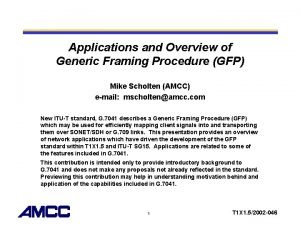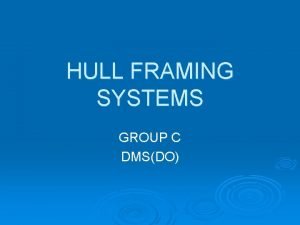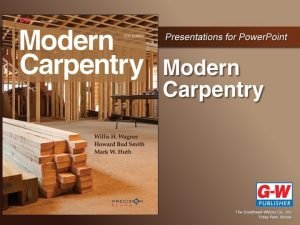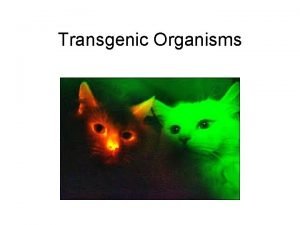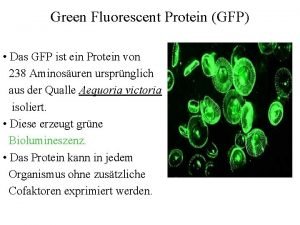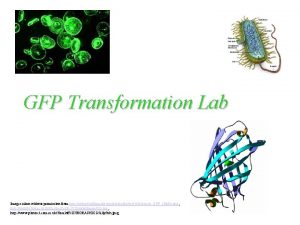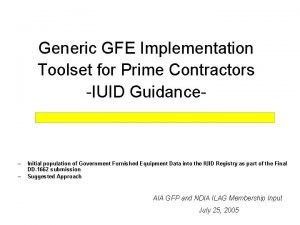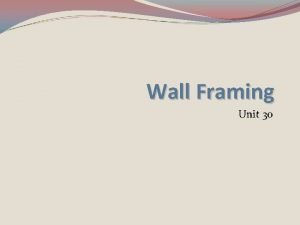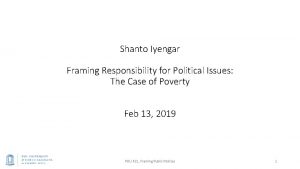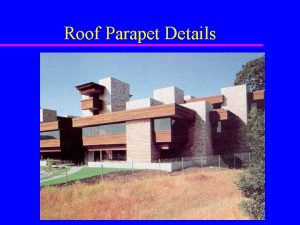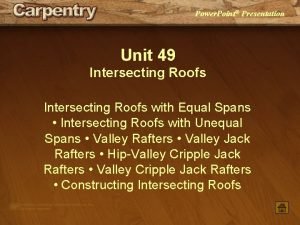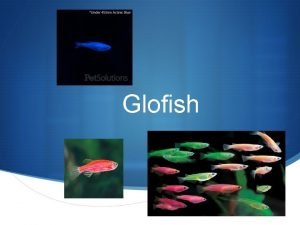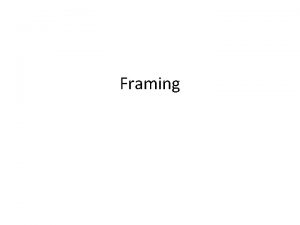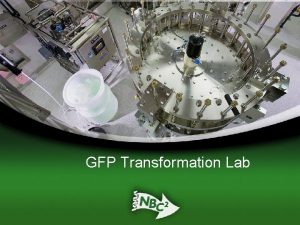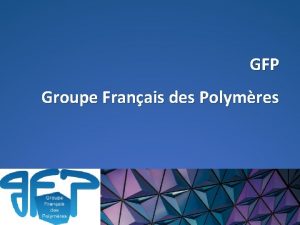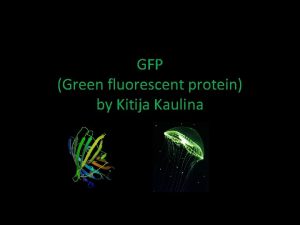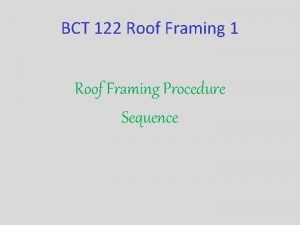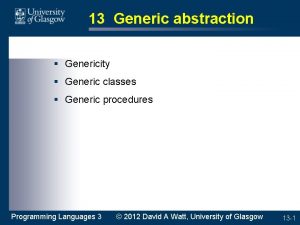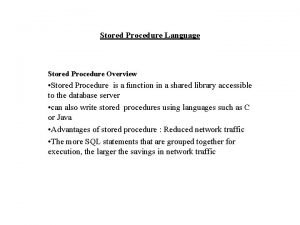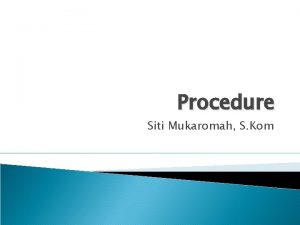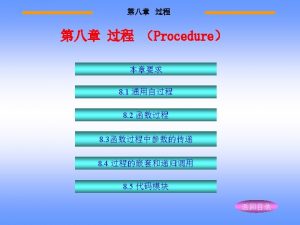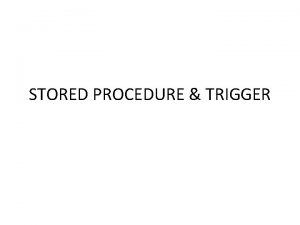Applications and Overview of Generic Framing Procedure GFP














![GFP Encapsulation of N x [536, 520] Superblocks Encapsulate N x [536, 520] superblocks GFP Encapsulation of N x [536, 520] Superblocks Encapsulate N x [536, 520] superblocks](https://slidetodoc.com/presentation_image_h/bad54e52d9b242222e3ca70f78b42a47/image-15.jpg)





- Slides: 20

Applications and Overview of Generic Framing Procedure (GFP) Mike Scholten (AMCC) e-mail: mscholten@amcc. com New ITU-T standard, G. 7041 describes a Generic Framing Procedure (GFP) which may be used for efficiently mapping client signals into and transporting them over SONET/SDH or G. 709 links. This presentation provides an overview of network applications which have driven the development of the GFP standard within T 1 X 1. 5 and ITU-T SG 15. Applications are related to some of the features included in G. 7041. This contribution is intended only to provide introductory background to G. 7041 and does not make any proposals not already reflected in the standard. Previewing this contribution may help in understanding motivation behind application of the capabilities included in G. 7041. 1 T 1 X 1. 5/2002 -046

What is GFP? • • Emerging new standard for Data Encapsulation Accept any client, encapsulate in simple frame, transport over network Uses length/HEC frame delineation of variable length packets Allows multiple data streams to be transported over single path – Packet aggregation for router applications – Common encapsulation of different client data types (e. g. Ethernet, HDLC) • Transparent Mapping supports LAN/SAN extension over WAN • Extension headers support various network topologies – Null Extension Header for channelized Point-to-Point network – Linear Extension Header for Port Aggregation over Point-to-Point network – Ring Header for Resilient Packet Ring applications (removed to Living List) 2 T 1 X 1. 5/2002 -046

Basic GFP Frame Structure Payload Type MSB Length MSB Payload Type LSB t. HEC MSB t. HEC LSB Ext Hdr Byte 1 Ext Hdr Byte 2 Length LSB c. HEC MSB c. HEC LSB Core Header Payload Area Payload Ext Hdr Byte n e. HEC MSB e. HEC LSB Optional Extension Header FCS (optional) FCS[31: 24] FCS[23: 16] FCS[15: 8] FCS[7: 0] 3 T 1 X 1. 5/2002 -046

Application: Packet Routing through Big Fat Pipes Edge Switch N x Gb. E Packet Switch SPI-3 SPI-4 SONET SDH Mapper OC-48 STM-16 OC-192 STM-64 Router-based WAN • Packet Switch encodes/decodes 8 B/10 B and routes packets to appropriate SPI-n • SONET/SDH Mapper encapsulates packets using PPP over GFP and maps them into concatenated payload (STS-48 c/VC-4 -16 c or STS-192 c/VC-4 -64 c) – Alternative to POS using PPP or Eo. S/LAPS using PPP – Avoids indeterminate bandwidth expansion due to HDLC transparency processing • All packet switching in WAN handled by Layer 2 routing • Single traffic type aggregated in edge switch & routers into big-fat-pipes going to desired hop in routing table • Control info from 8 B/10 B encoding not preserved • Relies on PPP for Link Configuration 4 T 1 X 1. 5/2002 -046

GFP Frame: PPP Packet Routing via GFP Payload Type MSB Length MSB Payload Type LSB t. HEC MSB t. HEC LSB Length LSB c. HEC MSB c. HEC LSB Core Header Payload Area PPP Packet Payload FCS (optional) FCS[31: 24] FCS[23: 16] FCS[15: 8] FCS[7: 0] 5 T 1 X 1. 5/2002 -046

Application: Port Aggregation over Digital Wrapper Edge Switch OTN Mapper N x Gb. E Packet Switch OTU-1 DWDM WAN SPI-3 SPI-4 OTN Mapper OTU-2 Packet Switch encodes/decodes 8 B/10 B and routes packets to appropriate SPI-n OTN Mapper encapsulates packets using GFP with extension header and aggregates them into OPU-n payload. Single or multiple traffic types may be aggregated in edge switch onto single wavelength Control info from 8 B/10 B encoding not preserved 6 T 1 X 1. 5/2002 -046

GFP Frame: Packet Aggregation over OTU-n Payload Type MSB Length MSB c. HEC MSB Payload Type LSB t. HEC MSB t. HEC LSB c. HEC LSB Channel ID Payload Header Spare e. HEC MSB Length LSB Core Header Payload Area e. HEC LSB Linear Extension Header Packet Payload FCS (optional) FCS[31: 24] FCS[23: 16] FCS[15: 8] FCS[7: 0] 7 T 1 X 1. 5/2002 -046

Application: Resilient Packet Rings 8 B/10 B Client OC-m STM-n Gb. E MAC SPI-n Packet Stream HDLC Proc. Network Process. & Switch SPI-n SONET SDH Mapper Framer Ring Node • • • Ring Node Packet Ring Node Multiplex packet streams into single STS-Nc / VC-4 -Xc Packet Add/Drop Each packet encapsulated into GFP Frame Payload Type ID in payload header supports multi-service applications Allows spatial reuse (packet statistical muxing, rather than TDM at each node) GFP Extension headers support RPR • Ring Node addressing • Class of Service packet prioritization • 802. 17 RPR WG developed alternative to GFP extension Ring Header: • RPR MAC generates/processes non-GFP ring header which is presented to GFP as part of payload 8 T 1 X 1. 5/2002 -046

GFP Frame: RPR Using GFP Ring Header Length MSB Length LSB c. HEC MSB c. HEC LSB Core Header Payload Area Ring Extension Header Packet Payload FCS (optional) FCS[31: 24] FCS[23: 16] NOTE: GFP Ring Header removed to Living List; 802. 17 RPR proposes to include ring header as part of GFP payload). FCS[15: 8] FCS[7: 0] 9 Payload Type MSB Payload Type LSB t. HEC MSB t. HEC LSB Dest. Port Src. Port Spare DE Co. S TTL Dest MAC[47: 40] Dest MAC[39: 32] Dest MAC[31: 24] Dest MAC[23: 16] Dest MAC[15: 8] Dest MAC[7: 0] Src MAC[47: 40] Src MAC[39: 32] Src MAC[31: 24] Src MAC[23: 16] Src MAC[15: 8] Src MAC[7: 0] e. HEC MSB e. HEC LSB T 1 X 1. 5/2002 -046

Application: Extending LAN / SAN over WAN Gb. E FC LAN / SAN Gb. E FC 8 B/10 B Clients SONET SDH Mapper Framer SONET / SDH Network STS-m STM-n SONET 8 B/10 B Client SDH Mapper Framer Gb. E FC • Want to preserve individual 8 B/10 B block-coded channels, but…. . . Cannot fit two 1. 25 Gb/s Gb. E channels into a single OC-48 / STM-16 • Transport of single 1. 25 Gb/s stream over OC-48 / STM-16 is excessively wasteful. • Need to preserve control info (e. g. link configuration) for LAN extension, so… …Cannot just send data packets. • Cannot just interleave two streams into single path and still expect SONET/SDH to deliver to different destinations. 10 T 1 X 1. 5/2002 -046

SAN Transport through Right-Sized Pipes using VC/GFP Nx Fibre Chan, Gb. E, SAN - WAN PHY FICON, ESCON Transparent 8 B/10 B Encapsulate Codec / Extract • • • SONET SDH Mapper with VC OC-48/STM-16 or OC-192/STM-64 SONET/SDH Switched WAN Transparent Encapsulation / Decapsulation preserves Control Info Virtually-concatenated paths sized to fit individual client signals Client signals preserved intact through the network Signals routed by switching VC paths (STS-1/VC-3 or STS-3 c/VC-4 switching) Mix of protocols may be carried, each in its own VC path Virtual Concatenation (VC) essential to compete against SAN over dark fiber 11 T 1 X 1. 5/2002 -046

Solution: VC + Transparent GFP • • • Use Virtual Concatenation (VC) to partition SONET/SDH link into “right-sized” pipes “Right-sized” is smallest number of STS-3 c/VC-4 or STS-1/VC-3 needed for client Compress 8 B/10 B client without losing control information Encapsulate compressed client signal into standard adaptation mechanism (GFP) T 1 X 1. 5/2000 -046 (Jul-2000) established target VC-path sizes for various clients: – Gigabit Ethernet • 1000 Mb/s; 1250 Mb/s 8 B/10 B block-coded fit into STS-3 c-7 v or VC-4 -7 v • 2 STS-3 c/VC-4 available after 2 Gb. E signals VC-mapped into OC-48/STM-16 – Fibre Channel and FICON • 850 Mb/s; 1062. 5 Mb/s 8 B/10 B block-coded fit into STS-3 c-6 v or VC-4 -6 v • 4 STS-3 c/VC-4 available after 2 Fibre Channel signals VC-mapped into OC-48/STM-16 – ESCON • 160 Mb/s; 200 Mb/s 8 B/10 B block-coded fit into STS-1 -4 v or VC-3 -4 v • 12 ESCON signals can be VC-mapped into OC-48/STM-16 12 T 1 X 1. 5/2002 -046

Solution: VC + Transparent GFP (cont. ) • T 1 X 1. 5/2001 -04 R 1 (Jan-2001) established 64 B/65 B compression scheme: – Map 8 -bit data directly into 64 -bit block with pre-pended Sync. Bit = 0 – Map 12 control characters into 3 -bit location + 4 -bit control code 13 T 1 X 1. 5/2002 -046

Transparent GFP Mapping (cont. ) • 12 8 B/10 B “Special Characters” remapped to 4 -bit codes as shown • 10 B Violations mapped as “ 10 B_ERR” (RD errs, unrecognized 10 B codes) • Rate adapt by inserting “ 65 B_PAD” code 14 T 1 X 1. 5/2002 -046
![GFP Encapsulation of N x 536 520 Superblocks Encapsulate N x 536 520 superblocks GFP Encapsulation of N x [536, 520] Superblocks Encapsulate N x [536, 520] superblocks](https://slidetodoc.com/presentation_image_h/bad54e52d9b242222e3ca70f78b42a47/image-15.jpg)
GFP Encapsulation of N x [536, 520] Superblocks Encapsulate N x [536, 520] superblocks into standard GFP Frames • • • Relocate leading “sync bits” of 8 x 65 B blocks to end of 8 x 64 -bit blocks Compute & append CRC-16 after 8 x 65 B blocks to create [536, 520] superblock maintains byte alignment Choose N to fit available bandwidth of selected virtually-concatenated path Scramble Payload Area using self-synchronous x 43+1 scrambler Leading Bit 8 byte block 8 x 65 B blocks = 520 bits 1. Group 8 x 65 B blocks 2. Rearrange Leading Bits at end 3. Generate & append CRC-16 checkbits to form [536, 520] superblock. 4. Pre-pend with GFP core & payload headers. 5. Scramble payload header & payload with x 43+1. (Core header not scrambled. ) 6. Form GFP frames with N x [536, 520] superblocks. Payload Header (4 bytes) Core Header (4 bytes) N x [536, 520] Superblocks Optional FCS (4 bytes) 15 T 1 X 1. 5/2002 -046

Handling 8 B/10 B Disparity Transp. Client 8 B/10 B Client GFP Source • 1. 25 Gb/s Gb. E, Mapper • 1. 0625 Gb/s FC Framer STS-m STM-n SONET / SDH Network STS-m STM-n Transp. GFP De-map 8 B/10 B Client Sink or FICON, • 200 Mb/s ESCON Client Ingress Client Transport Client Egress Ingress Code Violations Detected: Egress Codeword Generation: • Invalid Codewords • Running Disparity Errors • Map 10 B_ERR into GFP Frame. • Generate correct disparity. • Prevent disparity error propagation across data packets. • Handle received 10 B_ERR. 16 T 1 X 1. 5/2002 -046

Signal Fail Handling in Transparent Mapping Transp. Client 8 B/10 B Client GFP Source • 1. 25 Gb/s Gb. E, Mapper • 1. 0625 Gb/s FC Framer STS-m STM-n Transp. GFP De-map SONET / SDH Network 8 B/10 B Client Sink or FICON, • 200 Mb/s ESCON Client Ingress Client Transport Client Egress Signal Fail Handling on Egress: Signal Fail Conditions on Ingress: • Locally detected Signal Fail • Protocol-specific Client Signal Failures • • • Loss of Signal GFP_CSF • Loss of Synchronization GFP_CSF Section / RS defects (LOS, OOF/LOF, RS-TIM) 10 B_ERRs Line / MS defects (AIS-L) 10 B_ERRs Path defects (LOP-P, PLM, UNEQ, MS-TIM) 10 B_ERRs VC-Path defects (d. LOM, d. SQM, d. LOA) 10 B_ERRs GFP Frame Sync Loss 10 B_ERRs • Received Signal Fail conditions • GFP_CSF 10 B_ERRs • Handling of non-failure errors • Errored 8 x 65 B Superblock 8 x 8 10 B_ERR chars • Non-decodable 65 B Block 8 x 10 B_ERR chars Definitions: GFP_CSF = GFP Client Mgt Frame with Client Signal Fail Indication 10 B_ERRs = stream of consecutive 10 B_ERR codewords 17 T 1 X 1. 5/2002 -046

Clocking Options for Egress Client Signals Transp. Client 8 B/10 B Client GFP Source • 1. 25 Gb/s Gb. E, Mapper • 1. 0625 Gb/s FC Framer STS-m STM-n SONET / SDH Network STS-m STM-n Transp. GFP De-map 8 B/10 B Client Sink or FICON, • 200 Mb/s ESCON Client Ingress Client Transport Client Egress Clock Options: • Recover Client clock from transported GFP-mapped client signal; or • Rate adapt extracted client to locally derived client reference clock. 18 T 1 X 1. 5/2002 -046

Frame-Mapped GFP vs. Transparent GFP 19 T 1 X 1. 5/2002 -046

GFP Overview Summary • Various GFP Applications have been described and illustrated – – Packet routing Port aggregation over SONET/SDH or OTN using Linear Extension Headers Resilient Packet Ring applications using Ring Extension Headers Transparent Transport of 8 B/10 B clients • Basic GFP Frame Structure has been described and shown – Length/c. HEC frame delineation, similar to ATM cell delineation. – Payload Headers ID encapsulated payload & encapsulation options • • • Presence or absence of optional FCS Presence and type or absence of extension header Payload type allows for mixing data types in a single SONET/SDH or OTN path – Extension headers support various network topologies • • • Null Extension Header for channelized Point-to-Point network Linear Extension Header for Port Aggregation over Point-to-Point network Ring Header for Resilient Packet Ring applications • LAN/SAN extension over WAN using Transparent Mapping described and shown – 64 B/65 B re-coding preserves data & control for “transparent” transport – [536, 520] superblocks provide error detection / correction over relatively small blocks – Supports efficient transport of full-rate 8 B/10 B clients over smallest paths • Foundation laid for more easily understanding ITU-T G. 7041 GFP Standard 20 T 1 X 1. 5/2002 -046
 Generic framing procedure
Generic framing procedure Transverse framing
Transverse framing Balloon framing details
Balloon framing details Stealer plate in ship construction
Stealer plate in ship construction Gfp jellyfish
Gfp jellyfish Was ist gfp
Was ist gfp Gfp gene
Gfp gene Gfp purification flow chart
Gfp purification flow chart Gfe vs gfp
Gfe vs gfp Cheek cut rafter
Cheek cut rafter The shorter and narrower part of the framing square
The shorter and narrower part of the framing square Vectors in visual literacy
Vectors in visual literacy Wood frame components
Wood frame components Distance between studs
Distance between studs Framing visual technique
Framing visual technique Rule 1 quotes
Rule 1 quotes Iyengar framing
Iyengar framing Parapet wall details
Parapet wall details Golden rule of framing the prospectus means
Golden rule of framing the prospectus means Laurie bassi
Laurie bassi Roof valley construction
Roof valley construction
